TAMING THE BROWNSTONE MONSTER (1921)
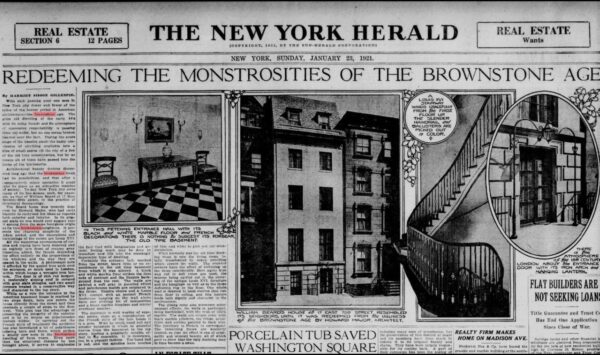
******************************************************************************************************************************** Brownstone Detectives investigates the history of our clients’ homes. The story you are about to read was composed from research conducted in the course of one of those investigations. Do you know the history of YOUR house? ******************************************************************************************************************************** By the 1920s, many New Yorkers had moved on from the brownstone. In fact, articles were being written on just how exactly to move on from what was seen as these “monstrosities.” Following the recommendations of self-appointed design entusiasts and contractors with an eye for the moderne, many brownstone townhouses were shaved of their detail and turned into drab brown boxes. The following story, dripping with sarcasm and barely veiled condescension, appeared in the New York Herald, showing just how the monstrosity at No. 17 East 75th Street was tamed.– Courtesy of The New York Herald, Sun., 23 January 1921 By HARRIET SISSON GILLESPIE. With each passing year one sees in New York city fewer and fewer of the relics of the horror period in American architecture the brownstone age. The grim old dwelling of the early 80’s with its sulky facade and its atmosphere of oppressive respectability is passing from our midst, but no one seems broken hearted over the fact. During the acute stage of the housing panic the hasty conversion of anything available into a hive of small suites rid the city of a few of the old time monstrosities, but by no means all of them have passed into the limbo of the kitchenette. Architectural beauty doctors […]
THE FARMS LINES OF BROOKLYN (1874)
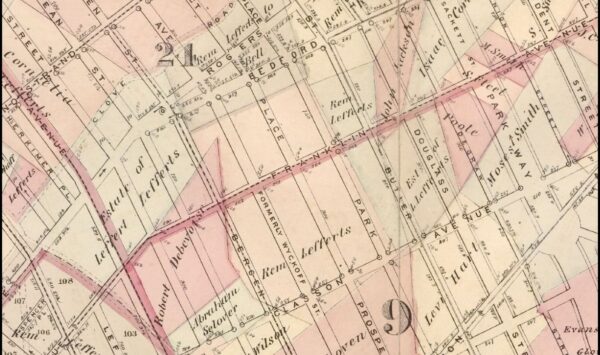
******************************************************************************************************************************** Brownstone Detectives investigates the history of our clients’ homes. The story you are about to read was composed from research conducted in the course of one of those investigations. Do you know the history of YOUR house? ******************************************************************************************************************************** Brooklyn was once one giant farm. At some point, as the farms began to be split up to be sold to developers – those who wanted to build rows of prized brownstones – companies also began to pop up which developed maps showing what types of buildings existed on every “lot” within the city. Although no longer used for fire insurance purposes, they are great tools for those owners wishing to research the histories of their properties. If you own a home in New York City, these maps can help you to determine how old it is, what else had been built in the area when your house was new, and, on some maps, the name of the farmer that had once owned your land. Find yours HERE. Follow @BrownstoneDetec Share ———————————————————————————————————————– The Brownstone Detectives Brownstone Detectives is an historic property research agency. Our mission is to document and save the histories of our clients’ homes. From our research, we produce our celebrated House History Books and House History Reports. Contact us today to begin discovering the history of your home.
THE “WEIRFIELD” HOUSE ON THE HILL (1850)
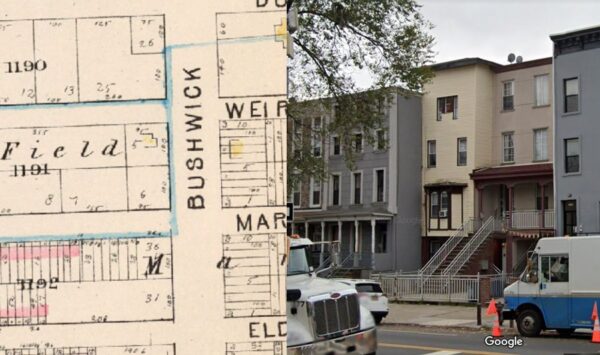
******************************************************************************************************************************** Brownstone Detectives investigates the history of our clients’ homes. The story you are about to read was composed from research conducted in the course of one of those investigations. Do you know the history of YOUR house? ******************************************************************************************************************************** If Bushwick Avenue were a family, it would likely be an entertainingly and curiously dysfunctional clan. It would maybe be something akin to that harmless uncle who comes to Thanksgiving dinner, doesn’t talk about politics, but engages in witty banter and sips a few too many vermouths. Some houses on the avenue present as mindlessly conforming rowhouses — lined up at attention like toy soldiers. Squeezed within some of those rows, however, we sometimes find structures that seem oh-so-slightly out-of-place – as though they were built in – and transported from – another time and galaxy. One such structure is a 172-year-old house that appears as though it should be sitting alone upon a hill with a view to unfolding valleys of pastureland. THE HOUSE ON THE HILL In the mid-1800s, No. 1250 Bushwick Avenue was the only house on the south side of Bushwick Avenue between Weirfield and Margaretta (Halsey) Streets. The house was erected in approximately 1850 and, in its day of glory, stood on a knoll about six feet above street level, flanked on either side by immense maple trees. The grounds sloped gently down to a stone wall, five feet above the grade of the street, which extended along the street frontage from Weirfield street to Margaretta […]
YOUR BROWNSTONE WAS NOT BUILT IN 1899
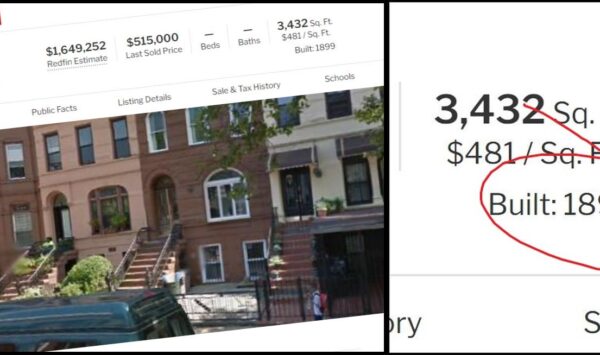
******************************************************************************************************************************** Brownstone Detectives investigates the history of our clients’ homes. The story you are about to read was composed from research conducted in the course of one of those investigations. Do you know the history of YOUR house? ******************************************************************************************************************************** We’ve all “Googled” ourselves, right? But have you ever Googled your house? Most people do this out of curiosity – just to see what might pop up. If you’ve ever done it, though, you were likely greeted with an extensive list of real estate sites that literally entreated you to click their links. Click on one of them and you may be surprised at what you find. Apparently, using their fancy algorithms, these sites can tell you nearly every detail under the sun about your property. These details include: the number of stories your house has, how many units are inside, the legal type of building it is, the district it lies within, its floor plans, the name of its neighborhood, its estimated value, various documents and permits filed, past sales, rental – and the list goes on and on… You may possibly even see images of the exterior of your rowhouse, as well as numerous snapshots of the inside (likely from a previous sale). For the most part you may note that everything – so far as you can tell – is relatively correct. There is, however, one very important piece of information that, on 99% of informational listings (including yours), is dead wrong… “BUILT IN 1899”? Why does nearly […]
NEW YORK CITY’S IRISH HOUSE OF LORDS (1912)
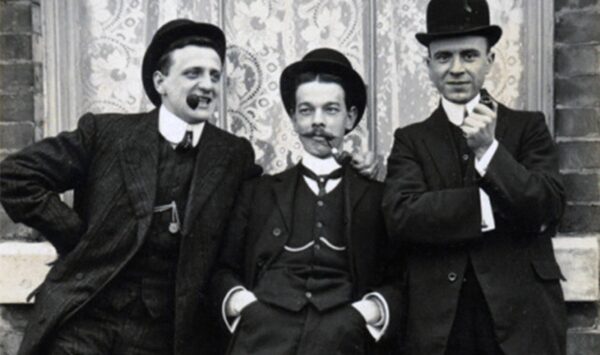
******************************************************************************************************************************** Brownstone Detectives investigates the history of our clients’ homes. The story you are about to read was composed from research conducted in the course of one of those investigations. Do you know the history of YOUR house? ******************************************************************************************************************************** “(New York City) is never the same city for a dozen years together. A man born in New York forty years ago finds nothing, absolutely nothing, of the New York he knew. If he chance to stumble upon a few old houses not yet leveled, he is fortunate. But the landmarks, the objects which marked the city to him, as a city, are gone.” – Harper’s Monthly, 1856 ******************************************************************************************************************************** It was an unassuming ancient wood-frame house – said to be one of the last of its kind in Yorkville – and it was entering its final Fenian days. The building, which had been purchased half a century before in 1860, at the princely sum of $10K, by the then-current owner, John Sheehy, had, through the death of said owner, been forced in 1912 upon the chopping block for sale to the highest bidder. The history of the structure, though, had been more known, in some ways, to the British War Department of the past half century than it had been, generally, to many of the locals of Yorkville where it had stood for more than most could remember. For, it had taken on the fantastical aura of the gathering place of patriots, as well as the auspicious mantel of the “Irish […]
HOW YOUR BROWNSTONE LOST ITS SOUL (1915)
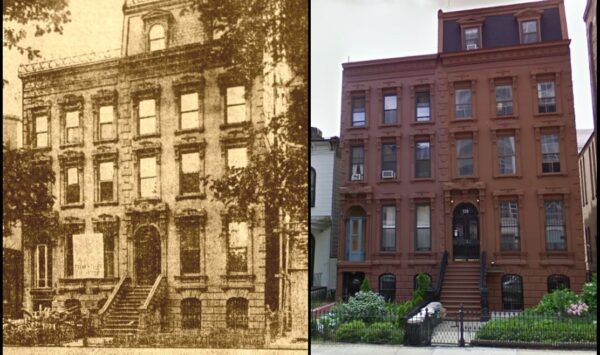
******************************************************************************************************************************** Brownstone Detectives investigates the history of our clients’ homes. The story you are about to read was composed from research conducted in the course of one of those investigations. Do you know the history of YOUR house? ******************************************************************************************************************************** It started just 20 years after construction began on “Brownstone Brooklyn” – our brownstones and townhouses began to lose their “souls.” Constructed in a time when owners needed three and four stories of room for large families, they had, in those times, existed as the epitome of style and class. Now that so much square footage so close to the city center was becoming too dear for so many residents (who did not have families or who needed much less room), builders were beginning to construct large apartment houses that provided all of the necessities of home within a smaller, but more stylish and efficiently laid out, space. Such competition from newer construction caused the formerly beloved brownstone to lose its lucrative “soul.” THE SOLUTION TO ANTIQUITY In 1915, real estate broker Frank Tyler struck upon an idea that turned out to be, in essence, a paradigm change: Take an old inefficient brownstone and turn it into a stylish and updated apartment house. Tyler noticed that “the average three-story and basement dwelling of old-fashioned style” had “become a drag on the real estate market.” Because of “great changes that have taken place in construction, and the popularity of apartment house living,” brownstone owners had been experiencing a decline in the rental […]
ROMEO & JULIET “COME TO” BROOKLYN (1866)
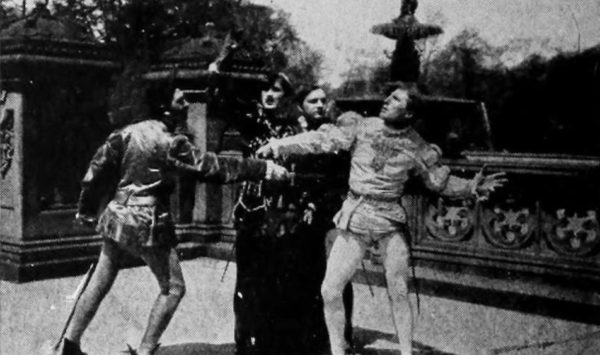
******************************************************************************************************************************** Brownstone Detectives investigates the history of our clients’ homes. The story you are about to read was composed from research conducted in the course of one of those investigations. Do you know the history of YOUR house? ******************************************************************************************************************************** The City of Brooklyn’s street grid system was still in its infancy in 1860, some 25 years after it had originally been laid out in Brooklyn maps in 1835. As builders began to buy up land, and as city elders watched the progress of speculative construction move continuously eastwards, it became apparent that some adjustments to the street grid were going to be necessary. SHAKESPEARE TO THE RESCUE Throughout the early 1860s, various New York State legislators from Kings County – likely in consultation with builders, land owners, and lawyers – began to plan these adjustments. These adjustments would come into being in two ways: 1) as extensions of certain streets through land that had originally been planned for building purposes, as well as 2) the closures of certain other portions of streets that had made other parcels of land unusable for building purposes. Thus, a legislative amendment to the Commissioners’ Map of the City of Brooklyn was in the works, and Brooklyn senators, having consulted professionals on the proposed changes, got to work on the wording to make the needed adjustments. In the end, six adjustments would be proposed – one of which was the creation of the very Shakespearean street moniker, Verona Place. “WHAT’S IN A NAME?” Considering the […]
SUNSETTING ON A BED-STUY BOULEVARD (1909)
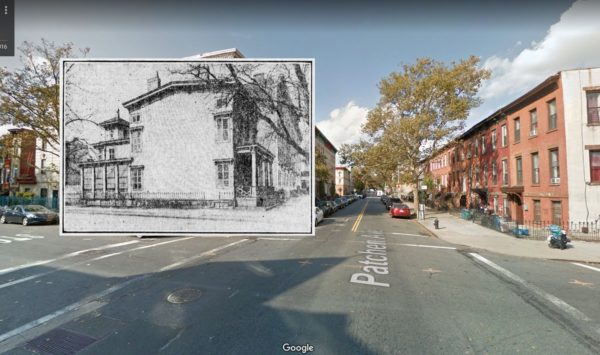
******************************************************************************************************************************** Brownstone Detectives investigates the history of our clients’ homes. The story you are about to read was composed from research conducted in the course of one of those investigations. Do you know the history of YOUR house? ********************************************************************************************************************************In 1909, a landmark was about to be destroyed. It was quite common, though, at the time for owners to tear down the antiquated wood-frame mansions that dotted Brooklyn’s landscape. Since the new brownstone houses had become all the rage in the 1880s, these tinder “firetraps” had become redundant, difficult to sell, and simply unstylish to live in. By the late 19th century, they were being sold, in many cases, for the value of their land as building lots. And with the demise of these historical artifacts, went some truly beautiful examples of mid-19th century architecture, few of which remain with us to this day. THE DE MILLE HOUSE The De Mille house was built around the middle of the 19th century for the family of that name, “and it has been a landmark in that region since the days when it was surrounded by open fields.” Yes, even Bedford-Stuyvesant – today chockablock with brownstone and masonry homes – was once – even before the advent of wood-frame homes – forested land alongside open virgin fields. As a matter of fact, the corner of Quincy and Patchen, in the 1850s, was little more than hills, dales, dirt lanes, and the vague promise of a future suburban city. “Broadway, which is nearby, was […]
THE ANATOMY OF A RACE RIOT (1862)
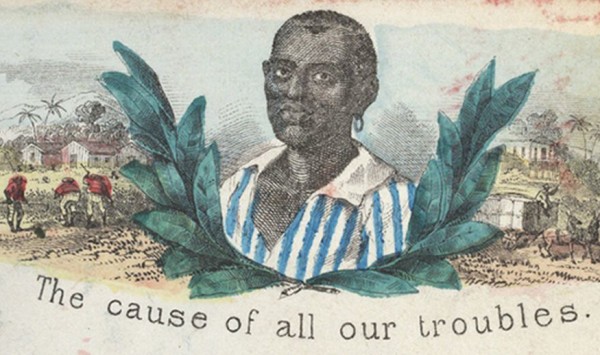
******************************************************************************************************************************** Brownstone Detectives investigates the history of its clients’ homes. The story you are about to read was composed from research conducted in the course of one of those investigations. ******************************************************************************************************************************** “Yesterday afternoon, one of the most disgraceful riots, which has ever happened in this city, took place…” So began the Brooklyn Daily Eagle‘s lead article about an “anti-Negro” riot that had taken place the previous day in the Red Hook section of Brooklyn. “…which, but for the timely appearance of the police, aided by some citizens, might have resulted in a most fearful tragedy.” HOW THE RIOT STARTED Days before the riot, though, “two (black) men who work in the rozin factory at the foot of Sedgewick Street were returning home from their work and stopped at Grady’s liquor store, in the neighborhood of the factories, to take a drink.” When a white man went to enter the establishment, he asked the “colored men” to move out of the way. When they refused, the spark that would light the kindling appeared. Of course, resentments and ill feelings had been brewing for some time, and this event, apparently, provided the “justification” for the backlash that was to come. After this minor liquor store incident – all through the night and into the next morning – various sorts of wild stories began to circulate and rumors to spread, including, unsurprisingly, unfounded accounts about “struck at the negroes with their clubs.”.” Then, when the morning arrived upon which the riot was incited, […]
SPRING BRINGS THE BEAN SHOOTERS (1863)
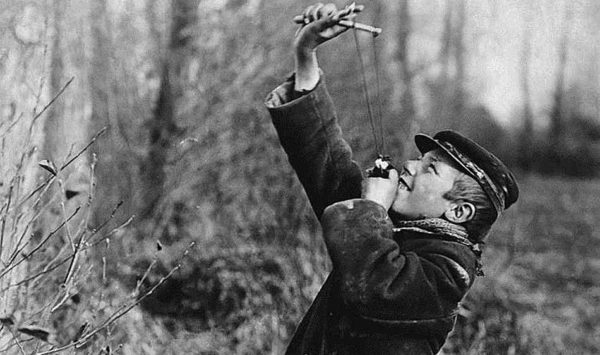
******************************************************************************************************************************** Brownstone Detectives investigates the history of our clients’ homes. The story you are about to read was composed from research conducted in the course of one of those investigations. Do you know the history of YOUR house? ******************************************************************************************************************************** There were a LOT of bad little boys in Brooklyn in the 19th century. Sifting through old issues of the Brooklyn Daily Eagle, the Standard Union, and other Brooklyn papers, I come across evidence of this on a daily basis. Of all the crimes that I see having been committed, one of the most common – and interesting – is the work of the “bean shooters.” When I was a kid I had a bean-shooter myself – and I did the same thing. There were a lot of broken window panes in my neighborhood – some I was found guilty of breaking – and most others of which I got away scot free of any blame whatsoever. (There was always the suspicion, though, that I was the culprit.) But I digress. Let’s rewind, though – further back to the mid- to late-1800s, and take a look at the work of my fierce little boy predecessors. BEAN-SHOOTING IN 19TH CENTURY BROOKLYN While sling shots (or often called “slung shots”) were a constant presence in the hands of gang members and criminals (they were outlawed by the New York State Legislature in 1849), it seems that the use of such a device by boys, with any degree of consistency, did not come until […]